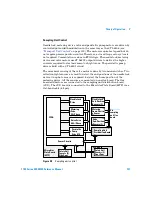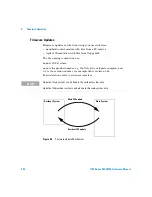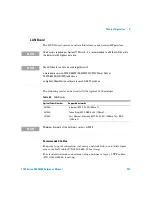
Theory of Operation
7
1100 Series WS MWS Reference Manual
231
RS-232C
The RS-232C connector is used to control the instrument from a computer
through RS-232C connection, using the appropriate software. This connector
can be activated by the configuration switch module next to the GPIB
connector.
The RS-232C is designed as DCE (Data Communication Equipment) with a
9-pin male SUB-D type connector. The pins are defined as follows:
6
POWER ON
(H) All modules connected to system are switched on. Receiver
is any module relying on operation of others.
7
READY
(H) System is ready for next analysis. Receiver is any sequence
controller.
8
STOP
(L) Request to reach system ready state as soon as possible
(for example, stop run, abort or finish and stop injection).
Receiver is any module performing run-time controlled
activities.
9
START REQUEST
(L) Request to start injection cycle (for example, by start key on
any module). Receiver is the autosampler.
Table 67
Remote Signal Distribution (continued)
Pin
Signal
Description
Table 68
RS-232C Connection Table
Pin
Direction
Function
1
In
DCD
2
In
RxD
3
Out
TxD
4
Out
DTR
5
Ground
6
In
DSR
7
Out
RTS
8
In
CTS
Summary of Contents for G1367A
Page 1: ...s1 Agilent 1100 Series Well plate Sampler Micro Well plate Sampler Reference Manual...
Page 4: ...4 1100 Series WS MWS Reference Manual...
Page 42: ...42 1100 Series WS MWS Reference Manual 1 Installing the Sampler...
Page 156: ...156 1100 Series WS MWS Reference Manual 4 Repairing the Sampler...
Page 196: ...196 1100 Series WS MWS Reference Manual 5 Parts and Materials...
Page 214: ...214 1100 Series WS MWS Reference Manual 6 Introduction to the Well plate Sampler...
Page 240: ...240 1100 Series WS MWS Reference Manual 7 Theory of Operation...
Page 276: ...276 1100 Series WS MWS Reference Manual 9 Specifications...
Page 284: ...284 1100 Series WS MWS Reference Manual Index...
Page 285: ......
















































